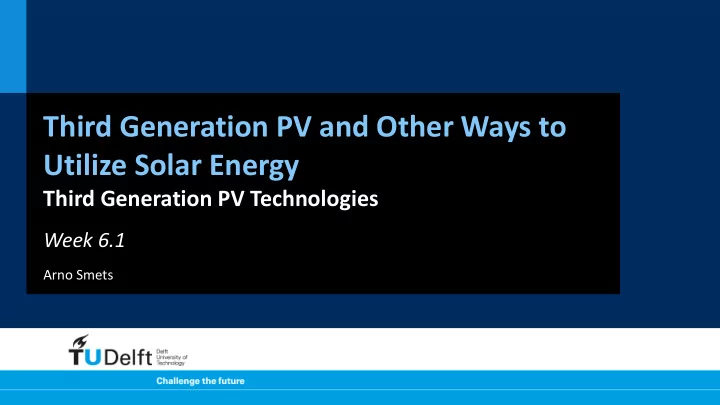

Third Generation PV and Other Ways to Utilize Solar Energy Third Generation PV Technologies Week 6.1 Arno Smets
` (Source: NASA)
Shockley-Queisser limit 100 Other losses Percentage of incident 75 Relaxation light energy Below-bandgap to band 50 photons edges 25 Usable electric power 0 0 1 2 3 Bandgap (eV)
Limitations Single bang gap energy C V “ Excess energy ”
Limitations Single bang gap energy 1-Sun irradiance
Limitations Single bang gap energy 1-Sun irradiance One e-h pair per photon
Limitations Single bang gap energy 1-Sun irradiance One e-h pair per photon No use of photon with E<E gap
Limitations Single bang gap energy 1-Sun irradiance C One e-h pair per photon V No use of photon with E<E gap Single population of e and h
Limitations Opportunities Single bang gap energy 1-Sun irradiance One e-h pair per photon No use of photon with E<E gap Single population of e and h
Multijunction C C V “ Excess “ Excess V energy ” energy ”
Limitations Opportunities Multijunction Single bang gap energy Concentrator Solar Cells 1-Sun irradiance One e-h pair per photon No use of photon with E<E gap Single population of e and h
Limitations Opportunities Multijunction Single bang gap energy Concentrator Solar Cells 1-Sun irradiance Down Conversion One e-h pair per photon Multiple Exciton Generation No use of photon with E<E gap Single population of e and h
Limitations Opportunities Multijunction Single bang gap energy Concentrator Solar Cells 1-Sun irradiance Down Conversion One e-h pair per photon Multiple Exciton Generation Up Conversion No use of photon with E<E gap Single population of e and h
Limitations Opportunities Multijunction Single bang gap energy Concentrator Solar Cells 1-Sun irradiance Down Conversion One e-h pair per photon Multiple Exciton Generation Up Conversion No use of photon with E<E gap Intermediate Band Solar Cells Single population of e and h Hot Carrier Solar Cells
Opportunity: down conversion e - e - e - c c versus v v h + h + h +
Opportunity: Multiple Exciton Generation E photon >2E gap e - heat e - e - e - e - C C C versus V V V h + h + h + h +
Quantum Dots CB 1P e CB 1S e E g 1S h VB 1P h VB 6 nm 2 nm
Down conversion: based on QDs Process: Si NC Si NC 1 CB CB 2 2 3 VB VB 1 3 3 3
Down conversion: based on QDs Process: Si NC Si NC 1 CB CB 2 2 VB VB 1
Down Conversion in QDs structures Jursberg et al, Appl. Phys. Lett. 233116 (2008)
Multiple Exciton Generation in QDs structures Semonin et al., Science 334, 1530 (2011).
Opportunity: up conversion e - c c versus v v h +
Opportunity: intermediate band solar cell Conduction band e - v h + Valence band
Opportunity: intermediate band solar cell Conduction band e - e - e - Intermediate band v v h + h + h + Valence band
Opportunity: Intermediate band solar cells Band-edge Built-in field metallic engineering Conduction Band E fn 1 3 Intermediate Band E fi 2 E fp Valence Band
Opportunity: Intermediate band solar cells qV + p n IB-material
Hot Carrier Solar Cell E BG hot electron and hole Energy distributions
Hot Carrier Solar Cell qV > qE gap qV E BG hot electron and hole Energy distributions
Hot Carrier Solar Cell Selective energy contacts E BG electron hot electron and hole contact Energy distributions
Hot Carrier Solar Cell Selective energy contacts E BG hole contact electron hot electron and hole contact Energy distributions
Hot Carrier Solar Cell qV > qE gap Selective energy contacts qV E BG hole contact electron hot electron and hole contact Energy distributions
` (Source: NASA)
Thank you for your attention!
Recommend
More recommend